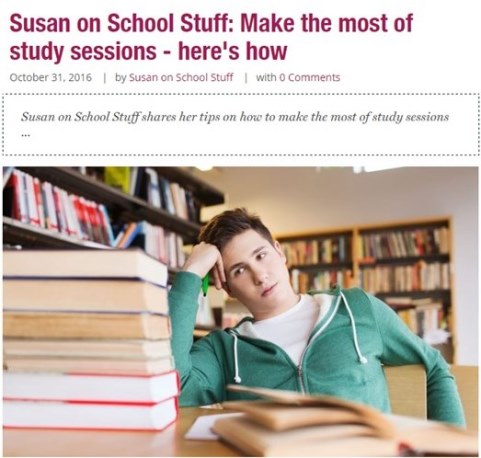
‘Susan on School Stuff’ is a column sponsored by Edublox on All4women.co.za, providing advice on learning to parents. This column was posted on 31 October 2016:
Dear Susan,
Thank you so much for your tips on enhancing concentration. I have worked them through with my Grade 8 daughter, whom I’m sure will benefit from your advice. Do you have any tips regarding study methods? How can she make the best use of her study sessions? We are both stressed out.
Tracy
***
Dear Tracy
It’s that time of the year when both learners and parents start to feel the heat of exam pressure. It’s normal for learners to be nervous about exams, but if they let stress get the better of them, it can actually cloud their mind and stop them from doing their best.
Becoming overly stressed or anxious can affect one’s memory, interfere with your sleeping patterns, mess with your appetite and negatively influence your health. Studying effectively can greatly help to reduce stress.
There are many study methods and depending on the content that needs to be studied, one has to choose between them. The SQ3R-method is a good method as it can be applied to study most subjects.
The SQ3R-method
Let us presume that we need to study History, and in particular the following paragraph regarding the attack on Pearl Harbor:
“Just before 8am on 7 December 1941, hundreds of Japanese fighter planes attacked the American naval base at Pearl Harbor near Honolulu, Hawaii. The barrage lasted just two hours, but it was devastating: The Japanese managed to destroy nearly 20 American naval vessels, including eight enormous battleships, and more than 300 airplanes. More than 2 000 Americans soldiers and sailors died in the attack, and another 1 000 were wounded. The day after the assault, President Franklin D Roosevelt asked Congress to declare war on Japan; Congress approved his declaration with just one dissenting vote. Three days later, Japanese allied Germany and Italy also declared war on the United States, and again Congress reciprocated. More than two years into the conflict, America had finally joined World War II.”.
Step 1: (S) Survey the content
Skim over the passage, identify ideas or facts and begin to formulate questions about the content of the passage.
Step 2: (Q) Question
Formulate detailed questions about the content, for example,
- What is this passage about? Answer: The Japanese attack on Pearl Harbor.
- What questions about Pearl Harbor are answered in the passage? Answer: When, what, how, who, etc.
- How does this information help me? Answer: It provides the date, time, place, detail and consequences.
Step 3: (R1) Read actively
Considering what you have taken in at a glance (skimmed) and the questions you have formulated regarding the passage, now read actively. Active reading implies that you read in order to gain the knowledge you need to answer the questions you have formulated in Step 2.
Be careful not to read passively, because passive reading is reading without really engaging in the content you have to study.
Step 4: (R2) Recite or write what you have read
Many learners prefer to write responses to their questions as formulated in Step 2, but you may find that you prefer to recite them, for example:
- When did this happen? 7 December 1941
- How long did the attack last? Two hours
- How did this happen? The Japanese destroyed nearly 20 American vessels, including eight big battleships and 300 airplanes
- How many deaths?
- How many wounded, etc.
Make sure that you answer these questions in your own words, therefore making the information your own. Learners who enjoy graphics may draw pictures to enhance their learning experience.
Step 5: (R3) Read and review
Use a sheet of paper, and test yourself. Recall the questions you have formulated, remember the key phrases and words and test your knowledge of the content. Make notes about forgotten information and return to actively reading the relevant parts again.
Repeat Steps 4 and 5 until you are confident that you know all the detail.
We have only covered one rather short passage. Longer passages and chapters can be studied in the same way. Some learners may prefer to break lengthy chapters into manageable parts. One thing to bear in mind though, is to make sure you know the headings AND the relevant contents of chapters and paragraphs, so that you can respond correctly during tests and examinations. The right answer to the “wrong” question can be avoided if you know your headings.
Regards,
Susan on School Stuff
Tips for sending questions
Send your questions to [email protected]
Try to give as much detail as possible when sending your questions. Include your child’s age and grade and the specific problems that you have noticed and are concerned about.
Sign your letter to Susan with your first name only, or a pseudonym if you wish your identity to remain private.






Leave a Reply